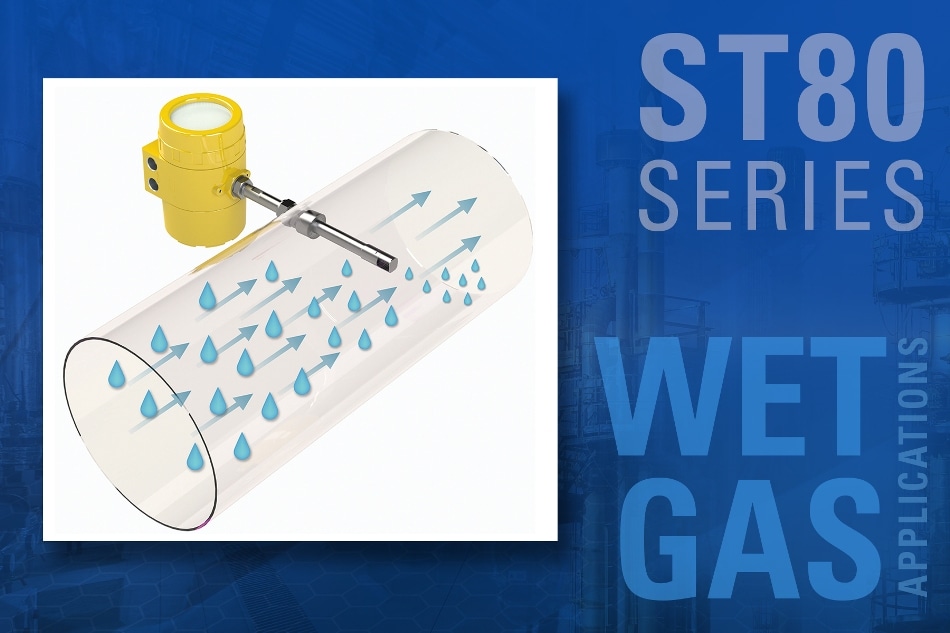As a leading innovator in the design of thermal mass flow meter technology and best application practices, Fluid Components International (FCI) announces the new optional Wet Gas MASSter Sensor™ for the ST80 Series Flow Meters.

FCI's new, innovative wet gas (WG) sensor delivers accurate, repeatable gas flow measurement in the presence of even more moisture and condensation droplets. Available with the Model ST80, this new WG sensor can be applied for use in entrained moisture and rain-shielding applications.
This advanced WG sensor configuration features a mechanical design that shunts moisture, condensation and water droplets away from the thermal flow sensor, thus maintaining an accurate gas flow measurement while minimizing errors that could occur from a cooling effect on the sensor that might cause a spike or false high reading. The Wet Gas MASSter Sensor option can be used in applications that have either moisture entrained in the gas (annular mist) or for protection against down the pipe rain in larger, vertical stacks.
A new Best Practices Guide To Measurement in Moist or Wet Gas explains how this advanced sensor configuration is designed for use in applications that have a high level of moisture or condensation present in the gas flow stream, which cannot otherwise be removed. Moisture in the pipe takes a variety of forms that can range from a fog to mist to actual liquid droplets that often includes corrosive components such as hydrogen sulfide (H2S).
The measuring principle of thermal mass flow meters involves heat transfer caused by gas flow. Any moisture or condensate in the gas stream that contacts the heated sensor can cause a sudden, momentary change in the heat transfer that can result in a spiked or fluctuating reading, which creates inaccurate or unstable flow measurement. Thermal flow meters using the constant temperature ∆T (CT) method are particularly reactive to moisture droplets, while constant power (CP) method meters, because their slightly heated sensor elevates the dew point, are less so.
Eliminating the moisture from the gas stream is always the preferred, best practice when possible. Common moisture removal methods include installing gas dryers or a knockout drums or knockout pots upstream from the flow meter. Many times, however, these techniques are either infeasible due to crowded equipment areas or awkward pipe configurations.
The new FCI Wet Gas MASSter Sensor option for the ST80 Series relies on standard thermal constant power (CP) technology and optimizes the sensor head design and installation to minimize or prevent condensation from contacting the sensor. The wet gas sensor head mechanically shunts the condensate away and never allows it to reach the sensors, which eliminates moisture interference with accurate, repeatable flow measurement.
This solution to wet gas measurement featuring the Wet Gas MASSter Sensor option for the ST80 Series Flow Meter offers a number of important advantages. First, all safety approvals remain in place because this is a mechanical solution. There is no increase in energy consumption to power the instrument, and there is no impact on sensor service life. Furthermore, there is no de-rating of the instrument's T-rating, and the sensor is safe to touch.
The rugged ST80 Series Flow Meters with the Wet Gas MASSter Sensor option are suitable for pipe diameters from 1 to 99 inches (25 to 2500 mm) and air/gas temperatures up to 850°F (454°C). They feature accuracy of ±1% of reading, ±0.5% of full scale and repeatability of ±0.5% of reading with flow rates up to 1000 SFPS (305 NMPS) and 100:1 turndown.
The ST80 Series outputs and user interfaces are extensive to ensure interfacing with virtually any control system and/or set-up or configuration devices. Standard outputs include dual 4-20 mA, NAMUR NE43 compliant analog outputs, HART (version 7), Modbus 485 and a USB port. Foundation Fieldbus or PROFIBUS PA can be optionally added. A best-in-class, backlit LCD display provides digital and bar graph readouts of the flow rate and temperature, totalized flow, alarms, diagnostics feedback and a user defined label field is also available.
The transmitter enclosure is NEMA 4X/IP67 rated, selectable for NPT or metric conduit port threading and is available in both aluminum and stainless steel and maybe remotely located up to 1000 feet (305 m) apart from the flow element. In addition to SIL rating, the instrument also carries full global instrument Div.1/Zone 1 Ex hazardous location approvals of FM, FMc, ATEX, and IECEx.
Fluid Components International is a global company committed to meeting the needs of its customers through innovative solutions for the most challenging requirements for sensing, and measuring flow, pressure and temperature of gases.